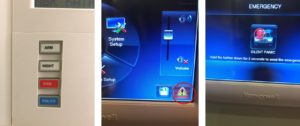
What you Need to Know about Panic Alarms
A security system is one of those things that you hope you never have to use but are so thankful for if you do. One lesser known feature of your alarm is the panic button. Under normal circumstances, if you have a monitored system, when your alarm is set, a breach will:
- set off the alarm
- activate the siren
- call the monitoring station
From there, the alarm company will follow the instructions you have set up. For many homeowners, the protocol is to call the contacts on your list to get instructions. The monitoring station will then call the police if requested.
False Start
A study by the Community Oriented Policing Services team of the Department of Justice found that between 94-98% of all burglar alarms were false alarms (www.cops.usdoj.gov). A false alarm means the alarm was set off accidentally or for some other reason than a crime in progress.
You hope that the siren going off will motivate the burglar to flee because of the noise. However, burglars may know that they have several minutes before any action will occur and therefore may not be deterred by an alarm. This is why understanding how and when to use a panic alarm is so important.
Panic Attack
A panic signal from your alarm system is handled differently than a regular alarm. First, the monitoring station will automatically report the alarm to the police without calling your contact list first. The police will be notified that it was a panic signal, meaning someone actively pushed the button to request a dispatch. They should respond more quickly as they do not assume it is a false alarm.
All keypads have a panic button but they may look different depending on your system type. If it is not obvious which button is the panic on yours, contact your alarm company to ask.

Examples of Panic Buttons
If you are home and a crime is occurring, try to get to your keypad to press this button. Press and hold for several seconds (this is set up to prevent accidental activation of the button). A monitored alarm will communicate to the monitoring station even if the alarm is disarmed.
You can also use your wireless keyfob to set off a panic. The range for the wireless is typically 200 feet from your alarm controller. Many people leave the keyfob by their bed at night so they can get to the panic in an emergency.
Take Note
There are a couple of important things to remember about your panic alarm and dispatching the police. First, you cannot trigger a panic signal from your smartphone or tablet app. If you are away from home and believe there is an intruder at your home (based on alarm activity, cameras, etc.), call 9-1-1 and alert them to a crime in progress.
Second, many jurisdictions require an alarm permit to have a monitored alarm. If you do not have an active alarm permit on file with your alarm company, the police can refuse to dispatch on an alarm, even if it is a panic signal. It is very important that you keep your burglar alarm permit current to prevent this from occurring and to avoid large fines.
We Can Help
Whether you need a new alarm system or just want to start monitoring on an existing system, Cultris Security Systems can help. Call us today at 281-506-8466 or visit us online.
Image Attribution

